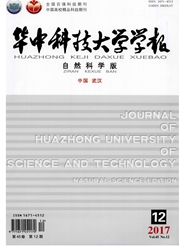

 中文摘要:
中文摘要:
以碳酸钾为催化剂分别将1(4),8(11),15(18),22(25)-四(4-羧基苯氧基)酞菁锌(1)和卜(4-羧基苯氧基)酞菁锌(2)与溴代乙酰糖基(乳糖、麦芽糖和葡萄糖)偶联,得到5种糖基酞菁偶联衍生物,IR,MS和UV—Vis光谱证实羧基酞菁与糖基成功偶联.糖基过量时,由1主要获得糖基二取代产物.溶解性和稳定性研究表明:5种偶联衍生物易溶或可溶于DMF、丙酮、THF、氯仿和甲醇中,不溶于水,它们在DMF中避光均能稳定存在.在DMF、丙酮、THF、甲醇和氯仿中它们显示相似的酞菁单体的电子吸收光谱,在体积分数O.1%DMF的水中出现聚集,这些体系中的Q带特征吸收峰位于670~690nm;在DMF和含O.1%DMF的水中的荧光量子产率分别为0.358-0.721与0.121~O.198,为原酞菁(1和2)的2~3倍和3~5倍.
 英文摘要:
英文摘要:
Five novel carbohydrate-conjugated derivatives from carboxylic zinc phthalocyanines were prepared from zinc (II) 1(4), 8(11), 15(18), 22(25)-tetrakis(4-carboxylphenoxy)phthalocyanine (1) or zinc(II) 1-(4-carboxylphenoxy) phthalocyanine (2) and O-acetyl glycosyl bromide of lactose, malt ose or glucose with newly roasted potassium carbonate as catalyst. The IR, MS and UV-Vis absorp tion spectra demonstrate that the conjugation has been achieved successfully. It is found that one com- pound 1 molecular was mainly combined with two glycosyl groups even though O-acetyl glycosyl bro mide was excessive. The solubility and stability of these five conjugates were investigated. Results show that they are freely soluble or soluble in DMF, Acetone, THF, chloroform and methanol and insoluble in water. All of them are stable in DMF kept in dark place. They exhibit similar monomer e lectronic absorption spectra in DMF, Acetone, THF, chloroform and methanol, whereas behave ag- gregated in water (containing 0.1% DMF). Their maximum absorption wavelength of Q band in these solvents appears at 670-690 nm. They give fluorescence quantum yields of 0. 358-0. 721 in DMF and 0. 121-0. 198 in water (containing 0.1% DMF), which are 2-3 times and 3-5 times those of o riginal phthalocyanines (1 and 2), respectively
 同期刊论文项目
同期刊论文项目
 同项目期刊论文
同项目期刊论文
 Synthesis and photobiological properties of novel silicon(IV) phthalocyanines axially modified by pa
Synthesis and photobiological properties of novel silicon(IV) phthalocyanines axially modified by pa Highly photostable silicon(IV) phthalocyanines containing adamantane moieties: synthesis, structure,
Highly photostable silicon(IV) phthalocyanines containing adamantane moieties: synthesis, structure, 期刊信息
期刊信息
